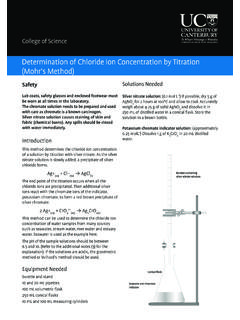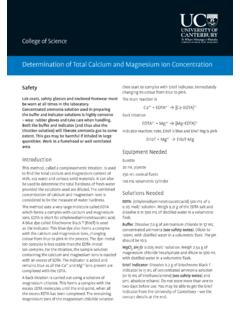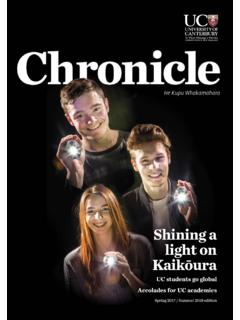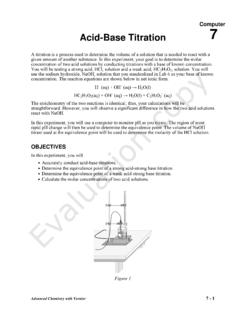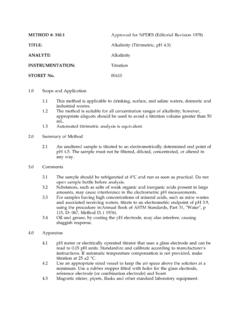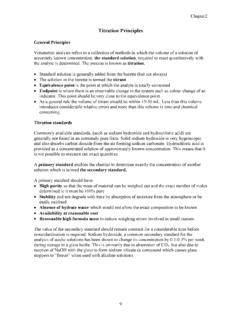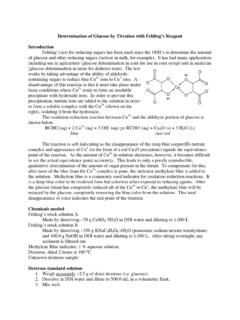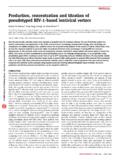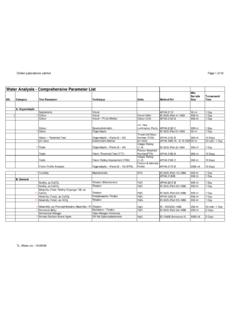Transcription of Determination of Vitamin C Concentration by Titration
1 College of ScienceSafetyLab coats, safety glasses and enclosed footwear must be worn at all times in the method determines the Vitamin C Concentration in a solution by a redox Titration using iodine. Vitamin C, more properly called ascorbic acid, is an essential antioxidant needed by the human body (see additional notes). As the iodine is added during the Titration , the ascorbic acid is oxidised to dehydroascorbic acid, while the iodine is reduced to iodide acid + I2 2 I + dehydroascorbic acidDue to this reaction, the iodine formed is immediately reduced to iodide as long as there is any ascorbic acid present. Once all the ascorbic acid has been oxidised, the excess iodine is free to react with the starch indicator, forming the blue-black starch-iodine complex.
2 This is the endpoint of the method is suitable for use with Vitamin C tablets, fresh or packaged fruit juices and solid fruits and : This method is more straight forward than the alternative method using potassium iodate, but as the potassium iodate solution is more stable than the iodine as a primary standard, the alternative method is more Neededburette and stand100 mL or 200 mL volumetric flask20 mL pipette10 mL and 100 mL measuring cylinders250 mL conical flasksSolutions NeededIodine solution: ( mol L 1). Weigh 2 g of potassium iodide into a 100 mL beaker. Weigh g of iodine and add it into the same beaker. Add a few mL of distilled water and swirl for a few minutes until iodine is dissolved. Transfer iodine solution to a 1 L volumetric flask, making sure to rinse all traces of solution into the volumetric flask using distilled water.
3 Make the solution up to the 1 L mark with distilled indicator solution: ( ). Weigh g of soluble starch and add it to 50 mL of near boiling water in a 100 mL conical flask. Stir to dissolve and cool before using.(Redox Titration Using Iodine Solution)1 Determination of Vitamin C Concentration by Titration (Redox Titration Using Iodine Solution)IntroductionThis method determines the Vitamin C Concentration in a solution by a redox Titration using iodine. Vitamin C, more properly called ascorbic acid, is an essential antioxidant needed by the human body (see additional notes). As the iodine is added during the Titration , the ascorbic acid is oxidised to dehydroascorbic acid, while the iodine is reduced to iodide ions. ascorbic acid + I2 2 I + dehydroascorbic acidDue to this reaction, the iodine formed is immediately reduced to iodide as long as there is any ascorbic acid present.
4 Once all the ascorbic acid has been oxidised, the excess iodine is free to react with the starch indicator, forming the blue-black starch-iodine complex. This is the endpoint of the Titration . The method is suitable for use with Vitamin C tablets, fresh or packaged fruit juices and solid fruits and vegetables. NB: This method is more straight forward than the alternative method using potassium iodate, but as the potassium iodate solution is more stable than the iodine as a primary standard, the alternative method is more Neededburette and stand100 mL or 200 mL volumetric flask20 mL pipette10 mL and 100 mL measuring cylinders250 mL conical flasksSolutions NeededIodine solution: ( mol L 1). Weigh 2 g of potassium iodide into a 100 mL beaker.
5 Weigh g of iodine and add it into the same beaker. Add a few mL of distilled water and swirl for a few minutes until iodine is dissolved. Transfer iodine solution to a 1 L volumetric flask, making sure to rinse all traces of solution into the volumetric flask using distilled water. Make the solution up to the 1 L mark with distilled water. Burette containing iodine solutionConical flaskVitamin C sample solutionDetermination of Vitamin C Concentration by TitrationMethodSample PreparationFor Vitamin C tablets: Dissolve a single tablet in 200 mL of distilled water (in a volumetric flask if possible).For fresh fruit juice: Strain the juice through cheesecloth to remove seeds and pulp which may block packaged fruit juice: This may also need to be strained through cheesecloth if it contains a lot of pulp or fruits and vegetables: Cut a 100 g sample into small pieces and grind in a mortar and pestle.
6 Add 10 mL portions of distilled water several times while grinding the sample, each time decanting off the liquid extract into a 100 mL volumetric flask. Finally, strain the ground fruit/vegetable pulp through cheesecloth, rinsing the pulp with a few 10 mL portions of water and collecting all filtrate and washings in the volumetric flask. Make the extracted solution up to 100 mL with distilled the 100 g sample of fruit or vegetable may be blended in a food processor together with about 50 mL of distilled water. After blending, strain the pulp through cheesecloth, washing it with a few 10mL portions of distilled water, and make the extracted solution up to 100 mL in a volumetric Pipette a 20 mL aliquot of the sample solution into a 250 mL conical flask and add about 150 mL of distilled water and 1 mL of starch indicator Titrate the sample with mol L 1 iodine solution.
7 The endpoint of the Titration is identified as the first permanent trace of a dark blue-black colour due to the starch-iodine Repeat the Titration with further aliquots of sample solution until you obtain concordant results (titres agreeing within mL).Calculations1. Calculate the average volume of iodine solution used from your concordant Calculate the moles of iodine Using the equation of the Titration (below) determine the number of moles of ascorbic acid acid + I2 2 I + dehydroascorbic acid4. Calculate the Concentration in mol L 1 of ascorbic acid in the solution obtained from fruit/vegetable/juice. Also, calculate the Concentration , in mg/100mL or mg/100g of ascorbic acid, in the sample of fruit/ Notes1.
8 Iodine stains both skin and clothing so proper care is advised. If staining does occur, alcohol may remove skin stains and cleaners are available for fabric Vitamin C, or ascorbic acid, is a water soluble antioxidant that plays a vital role in protecting the body from infection and disease. It is not synthesised by the human body and therefore must be acquired from dietary sources primarily fruits and vegetables. The chemical structure and antioxidant (reducing) action of ascorbic acid are illustrated in the redox half equation below:3. The Concentration of the prepared iodine solution can be more accurately determined by Titration with a standard solution of ascorbic acid or a standard solution of potassium thiosulfate using a starch indicator.
9 This should be done if possible as iodine solutions can be The average titre volume should ideally be in the range of 10 30 mL. If the titre required for a 20 mL aliquot of sample solution is well outside this range then a larger or smaller aliquot volume should be chosen. If the volume of the titre is too low, dilute the standard. If the titre volume is too high, dilute the Ascorbic acid is susceptible to oxidation by atmospheric oxygen over time. For this reason, the samples should be prepared immediately before the titrations . However, if the samples have to be prepared several hours earlier, oxidation can be minimised by the addition of a small amount of oxalic acid (eg 1 g oxalic acid per 100 mL of sample solution).
10 6. Identification of the endpoint in this Titration is significantly affected by the colouration of the sample solution used. If the solutions are colourless or are pale in colour, there is no problem identifying 2 Starch indicator solution: ( ). Weigh g of soluble starch and add it to 50 mL of near boiling water in a 100 mL conical flask. Stir to dissolve and cool before using. MethodSample PreparationFor Vitamin C tablets: Dissolve a single tablet in 200 mL of distilled water (in a volumetric flask if possible). For fresh fruit juice: Strain the juice through cheese cloth to remove seeds and pulp which may block packaged fruit juice: This may also need to be strained through cheese cloth if it contains a lot of pulp or fruits and vegetables: Cut a 100 g sample into small pieces and grind in a mortar and pestle.

